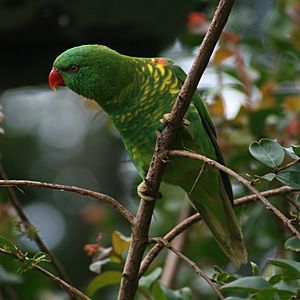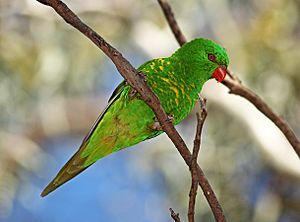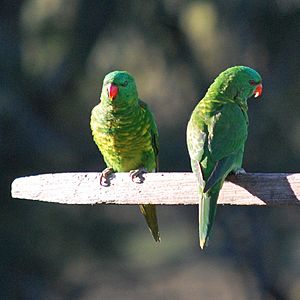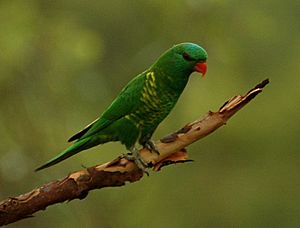Scaly-breasted lorikeet facts for kids
Quick facts for kids Scaly-breasted lorikeet |
|
|---|---|
 |
|
| Conservation status | |
| Scientific classification | |
| Genus: |
Trichoglossus
|
| Species: |
chlorolepidotus
|
The scaly-breasted lorikeet (Trichoglossus chlorolepidotus) is a colorful bird from Australia. It's a type of lorikeet that lives in woodlands in eastern Australia. This bird gets its name because its yellow chest feathers have green edges, making them look like scales.
Contents
About the Scaly-breasted Lorikeet
The scaly-breasted lorikeet was first described by a German scientist named Heinrich Kuhl in 1820. People also call this bird by many other names, like the green lorikeet, greenie, or even just "scaly." Its scientific name, chlorolepidotus, comes from ancient Greek words meaning 'green, yellow' and 'scaly'.
What Does a Scaly-breasted Lorikeet Look Like?
This lorikeet is about 23 centimeters (9 inches) long.
- Its head and the sides of its face are a bright emerald-green.
- The feathers on its neck, throat, and chest are yellow with wide green edges. This gives them their special "scaly" look.
- Its tail is green, and the outer tail feathers have orange-red at the bottom.
- The lower parts of its body, like its thighs and under its tail, are green with strong yellow markings.
- The feathers under its wings are orange-red.
- They have orange-red eyes and a dark coral-red beak.
- Their legs are usually grey-brown.
Both male and female scaly-breasted lorikeets look very similar. Young birds, called juveniles, look like the adults but have shorter tails. Their eyes might be pale brown or black, and their beaks can be brown with yellow or orange with brown.
Where Do Scaly-breasted Lorikeets Live?
These lorikeets are common in most wooded areas of Eastern Australia. You can find them from the very tip of North Queensland all the way south to the Illawarra area in New South Wales. They also live on some islands near the coast.
They mostly stay in coastal plains and nearby highlands. Sometimes, they are seen along rivers west of the Great Dividing Range. In the north, they are very common and tend to stay in one place. In the south, there are fewer of them, and they move around more. They prefer open areas with light trees and thickets of melaleuca trees.
How Do Scaly-breasted Lorikeets Behave?
It can be hard to spot these birds because their green feathers blend in so well with tree leaves. If you are standing under a tree where they are feeding, it might take a while to see them! Often, their bright coral-red beak is the first sign that they are there.
They like open areas with scattered trees, but you might also see them in melaleuca thickets when these trees are flowering. Scaly-breasted lorikeets usually fly in small groups. They often feed on the outer branches of flowering trees. They are common in most wooded areas and are often seen in gardens and parks, even in big cities.
These lorikeets fly very fast and in a straight line. When they fly overhead, you can hear the sound of their quick wing-beats along with their high-pitched calls.
Calls and Sounds
Scaly-breasted lorikeets are very noisy birds! They get attention with their loud screeching and chattering.
- When they fly, their call is a metallic, continuous screech.
- While they are eating, they make a shrill chatter.
- When they are resting, they have a soft, gentle twitter.
- As mating season gets closer, they can become even noisier, making loud tweets and squawks while looking for food.
What Do Scaly-breasted Lorikeets Eat?
Scaly-breasted lorikeets eat similar foods to their relatives, the rainbow lorikeet. These two species often feed together in mixed groups.
- They mainly eat nectar (the sweet liquid from flowers) and pollen. For example, they love nectar from the broad-leaved paperbark tree (Melaleuca quinquenervia).
- They also eat blossoms, berries, other fruit, and insects and their larvae (young insects).
- They are very fond of fruits grown in orchards and can sometimes damage crops.
- They also visit sorghum and maize (corn) fields to eat the unripe, milky grains.
Reproduction and Life Cycle
Scaly-breasted lorikeets can breed almost all year, except for March and April. However, they usually breed from August to January in the southern parts of their home range.
- They build their nests in hollow trees, usually high up off the ground.
- They put a layer of wood dust at the bottom of the hollow to make a soft bed.
- They usually lay two eggs, but sometimes three. The eggs are white, oval-shaped, and about 26 by 20 millimeters (about 1 by 0.8 inches).
- The eggs hatch after about 25 days of incubation.
- Male lorikeets spend time in the nest hollow, but it seems they don't help with incubating the eggs.
- Both parents feed the young birds.
- The young lorikeets leave the nest about six to eight weeks after they hatch.
Scaly-breasted Lorikeets as Pets
Scaly-breasted lorikeets can adapt quite well to living with humans. They are often playful and quiet, but they can sometimes be a bit aggressive. A special blue version of this bird, with dark blue feathers and white chest markings, has been bred in Australia.
See also
 In Spanish: Lori escuamiverde para niños
In Spanish: Lori escuamiverde para niños






